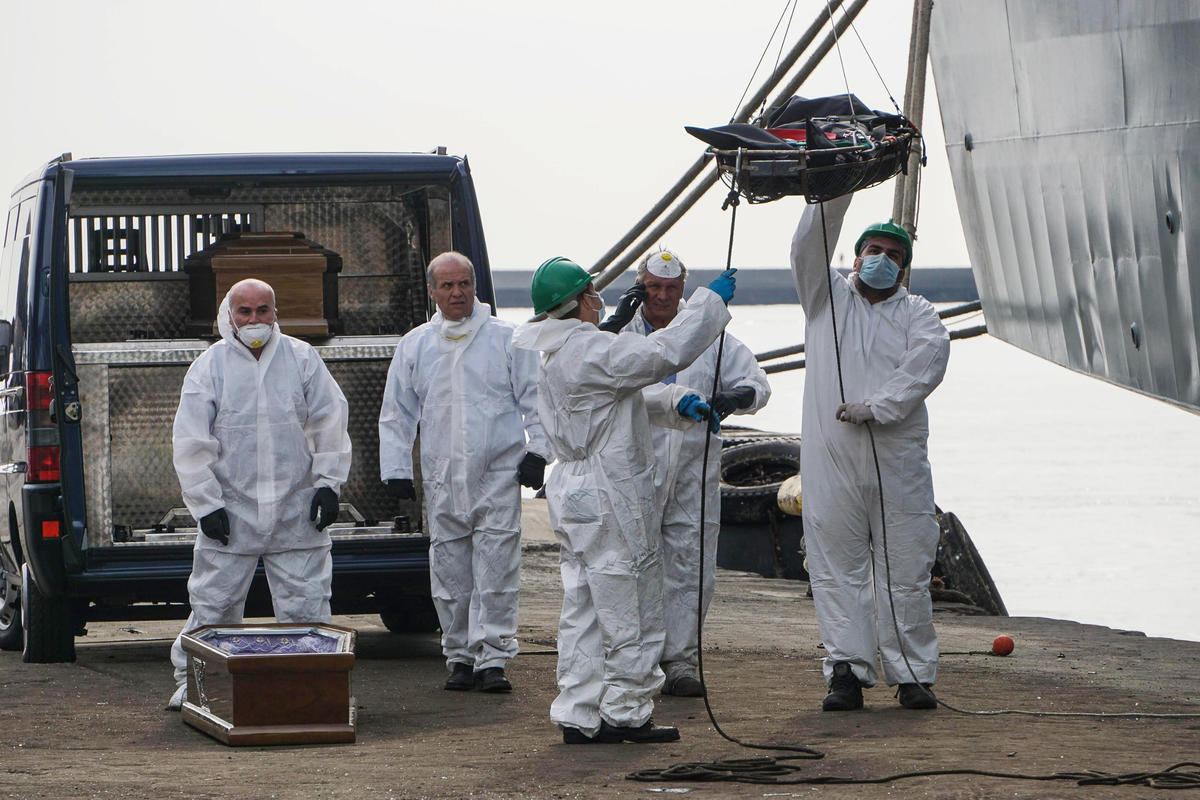
Rescuers recover a dead body from the Spanish ship ‘Cantabria’ in the harbour of Salerno, Italy, Sunday, Nov. 5 2017. UNHCR spokesman Marco Rotunno said that the 26 dead were involved in a shipwreck two days ago off Libya. (Cesare Abbate/ANSA via AP)
26 teenage girls were found dead at sea. Italian officials wonder if they were killed.
By Marwa Eltagouri
The Washington Post

Rescuers recover a dead body from the Spanish ship Cantabria in the harbor of Salerno, Italy, on Sunday. (Cesare Abbate/ANSA/AP)
The gruesome discovery Sunday of the bodies of more than two dozen migrant girls in the Mediterranean Sea has left Italian officials wondering whether the girls were purposely killed, and why all who died were female.
Lorena Ciccotti, police chief in the southern Italian port city of Salerno, told CNN that officials have launched an investigation into the girls’ cause of the death to see if they had been tortured or sexually assaulted. Officials believe the 26 girls, who are all Nigerian and range from 14 to 18 years old, died attempting the dangerous journey from Libya to Europe over the weekend.
Libya is the biggest launchpad for African migrants hoping to build new lives in Europe. Sub-Saharan Africans wishing to flee poverty or war have taken advantage of Libya’s power vacuum. Migrants’ desire to reach Italy — a country in close proximity to Libya — has made the North African country a center for human smuggling.
[The Waypoint: The Washington Post follows refugees on their journey]
The girls’ bodies were found in the Mediterranean by a Spanish vessel, which lowered a “seemingly endless line of black plastic body bags” onto a port in Salerno, according to Agence France-Presse. The bodies were placed in coffins, AFP reported. Twenty-three of the girls were discovered near a rubber dinghy that officials believe sank on Friday, according to AFP.
The trip across the Mediterranean is deadly — about 58 percent of the refugees who have died this year during their cross-border migration have drowned in the Mediterranean, according to the International Organization for Migration.
A top Salerno official, Salvatore Malfi, called the discovery a tragedy and told AFP authorities will “need to see whether there are suspects to concentrate on or whether the murder inquiry will proceed against persons unknown.”
Malfi said the girls may have been thrown off their rubber dinghy into the waters of the Mediterranean, according to NPR’s Sylvia Poggioli. “The cause of death appears to be by drowning.”
Women are more likely to drown because they cannot swim as well as men or because they sit on the lower levels of the vessels carrying them, away from life jackets, according to a 2012 study published in SAGE. Women might also try to rescue their children from drowning, putting them at greater risk of death.
The Spanish ship managed Sunday to rescue 90 women and 52 minors, including a newborn, officials told CNN. The rescue was one of four that altogether saved about 400 people over the course of the weekend.
So far this year through Nov. 1, about 151,000 migrants survived the journey across the Mediterranean to Europe, according to the International Organization for Migration. Almost 75 percent of those migrants — about 111,500 people — landed in Italy, with the rest reaching the shores of Greece, Cyprus and Spain. More than 2,800 migrants have died attempting the journey.
[Leaked documents reveal financial habits of Queen Elizabeth and Trump officials]
The Italian government, facing an unending flow of people from Africa and an increase in anti-migrant sentiments from its people, wants to limit the thousands of refugees arriving on its shores each month. The government has therefore agreed to pay Libyan militias willing to clamp down on human smuggling as part of an unusual deal.
As a result, alternate routes have experienced an uptick of migrant flows, with traffic from Morocco to Spain on the rise and more people embarking on the dangerous Black Sea journey from Turkey to Romania.
Since 2014, more than 400,000 migrants and refugees have crossed the Mediterranean from Libya to Italy.
The route from sub-Saharan Africa to Libya is also dangerous, especially for women. Women might endure sexual assault and rape and contract HIV as a result. One humanitarian worker told The Post about women she had met who were penetrated with objects such as guns. Perpetrators of sexual violence include security forces, smugglers and men aboard the rescue boats.
The Washington Post’s Sudarsan Raghavan explains what migrants attempting to travel to Europe face when the Libyan Coast Guard takes them in. (Jason Aldag, Sarah Parnass/The Washington Post)
In February, UNICEF reported that levels of sexual violence and abuse along the Central Mediterranean migration route made it one of “the world’s deadliest and most dangerous migrant routes for children and women.”
Malfi, the Salerno official, told AFP that investigators would look to see if the women had been assaulted.
“They were on a dinghy that was also carrying men,” he told Italian reporters who asked whether the women were on a sex-trafficking boat.